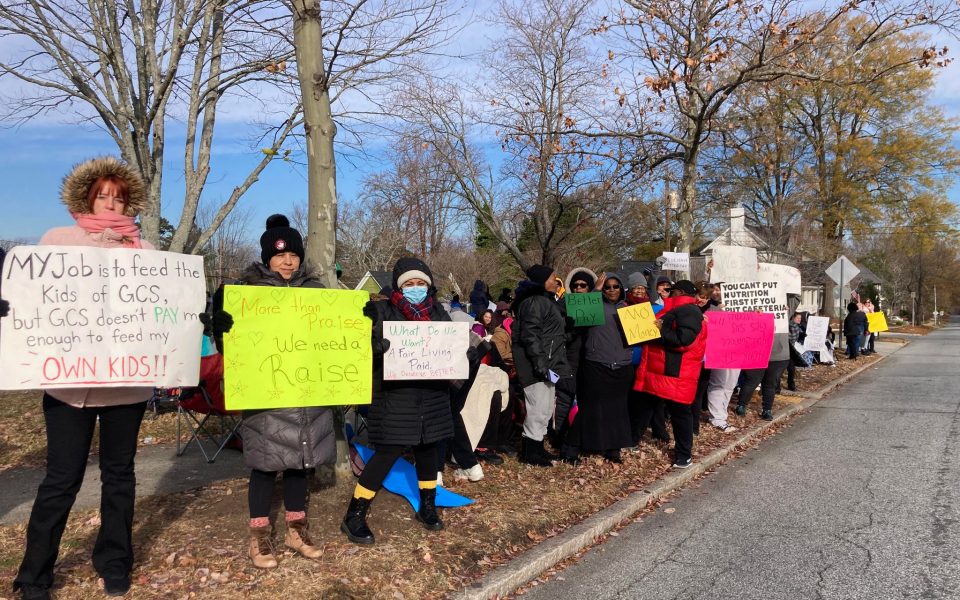Featured photo: Guilford County Schools cafeteria workers hold up signs during their second day of protest on Nov. 28. (photo by Sayaka Matsuoka)
Read previous reporting on this issue here and here.
Despite near-freezing temperatures, even more Guilford County Schools’ cafeteria workers were outside the district administration office on Tuesday morning, striking again for higher wages after rejecting the district’s new payment plan, which was unveiled on Monday.
According to Kelly Shepherd, Eastern High School’s cafeteria manager who has led the strike efforts, workers voted during a Zoom call on Monday evening to reject the new pay plan, which includes a 4 percent raise for cafeteria workers and a 7 percent raise for managers. The plan also adds quarterly bonuses for managers who serve more than 100 meals on average per day.
On Tuesday afternoon, district officials sent out a news release announcing a town hall for cafeteria workers at 4:30 p.m. at Hairston Middle School. According to the release, news media is not allowed at the town hall. A press conference will take place at 6 p.m.
‘People are just angry’
The new plan was unveiled Monday late afternoon at a press conference by district administrators including Superintendent Whitney Oakley. According to Oakley, the move to increase assistant cafeteria workers’ pay by 4 percent was always part of the plan, with the first 2.3 percent having been paid out in October. But a look at the district’s 2023-24 budget that passed last month doesn’t reflect those changes.
Either way, workers said that the increase isn’t enough — a 4 percent raise amounts to about 70 cents an hour — and what they want instead is a flat hourly raise to anywhere from $17-$20 an hour depending on the position.
“The problem is, people want more money,” Shepherd said on Tuesday morning. He wore the same grey fleece zip-up with the Guilford County Schools Nutrition emblem stitched on the right chest that he wore yesterday.
“They’re not satisfied with the 4 percent,” he said. “They want more money.”

On Monday, close to 200 workers went on strike. On Tuesday, the group was even larger.
According to district officials, one of the main issues is that nutrition workers are not funded by the state like bus drivers, custodians and other public school employees. So when most employees got a flat 4 percent raise when the state budget passed in October, nutrition workers were omitted. That left local municipalities — in this case, the county — to make up for the lack of funding by giving raises to nutrition workers.
But many cafeteria workers say that this isn’t the only issue. They point out that cafeteria workers are also the only classification of public school employees that don’t have “step” pay, which would pay workers based on years of experience on the job.
Lisa Hargrove, who works as the cafeteria manager at Jackson Middle School, said that she’s worked for Guilford County Schools for 22 years, and that she and others like her are tired of being underpaid.
“They just want to be paid for the work that they do,” she said, “and at this time, they don’t feel like they are.”
Currently, Hargove said that she works to feed anywhere from 400-500 kids per day for both breakfast and lunch service because there’s been an increase in the student population due to consolidation during school construction. Right now, first through fifth grade students who were zoned for Foust Elementary School are attending Jackson Middle School while their school is being rebuilt.
“You know, that’s a job I didn’t ask for,” Hargrove said.
She noted that she didn’t receive a raise when the workload increased. She also said it doesn’t make sense for a manager like her, with more than 20 years on the job, to make the same amount as someone just coming in.
Prior to the updated pay plan unveiled on Monday, cafeteria workers made about $15 per hour. Managers made about $18 per hour. With inflation and cost of living going up, workers say it’s not enough.
Shepherd said that if the district takes out the quarterly bonuses from their updated plan, which they didn’t ask for, then they should be able to raise workers’ pay to $18-20 an hour.

They’d also like to see the step pay reinstated.
“People are just angry,” Shepherd said. “And this is more than just about today. It’s about years worth of being left out of everything.”
What are teachers saying?
During the Monday press conference, Superintendent Oakley was clear to let parents know that schools would open as scheduled on Tuesday. Many parents and students remained confused for much of Monday as some educators sent students home with laptops for a potential remote-learning day on Tuesday.
Oakley also said during the Monday press conference that both breakfast and lunch would be served on Tuesday and that students were not allowed to order food for delivery using apps like DoorDash.

Sarah Jones, who works as a teacher at the Middle College at GTCC Jamestown, joined the picket line on Tuesday morning before work. She said that despite being associated with GTCC, their cafeteria is run by Guilford County Schools’ cafeteria workers.
“They come over from Ragsdale and bring us breakfast and lunch everyday,” Jones said.
As a teacher, Jones said she supports the strike by the workers because she understands what it’s like to be underpaid.
“This is just the tip of the iceberg,” Jones said. “Our public schools are underfunded and systematically being destroyed. We got a little raise that our district was able to give to teachers and other staff and they just left out the cafeteria folks. While it was not enough for everybody, the fact that they left out these important workers was just demoralizing.”

Andrew Ainsworth, an English teacher at Eastern Guilford High School, said that most educators like himself are holding the line by refusing to serve students while the cafeteria workers are striking. Instead, Ainsworth said that district staff and administrators came to the school to give out food. His students said that they were fed “burnt pizza” on Tuesday.
Yesterday, he said that teachers were asked to distribute food, which many of them refused in solidarity with the cafeteria workers. Students are also taking notice, with some choosing to order food to the schools or sit in solidarity with the workers.
“This has been a difficult situation for our school,” Ainsworth said. “It’s hard to teach kids who are worried about what’s for lunch. Students have started asking questions about what’s going on, and some are even putting up flyers in support of our nutritional staff.”

Jones and Ainsworth said they support the cafeteria staff.
“Our nutritional staff do so much for our school and deserve to be paid fairly for their work. We don’t have a school without them,” Ainsworth said.
Similarly, Jones views cafeteria staff as part of the vital public school ecosystem,
“I want these folks to know that they’re part of our team and that we are all educators together,” Jones said. “We’re not separate; they can’t separate us. We are a team with all our school workers, our custodians, our cafeteria folks, our bus drivers. They make it possible to do the job and without them, we don’t have school.”
Where’s the money?
As TCB has reported, the school district gave cafeteria workers a 2 percent raise after the state budget that passed last month excluded nutrition workers — who fall under the “classified staff” umbrella — from the standard 4 percent raise that other classified workers like custodians received. Bus drivers, who have also held a strike in the past for higher wages, received an additional average 2 percent salary increase on top of the 4 percent raise, according to reporting by Education NC.
In the spring, Guilford County Schools Superintendent Whitney Oakley announced that for the 2023-24 budget, they would ask for a $77.6 million investment from the county commissioners to address vacancies and increase pay for classified staff like nutrition workers. In the FY2024 adopted county budget, a line item shows that $15.4 million was approved by the county commissioners for Guilford County Schools “to support pay adjustments for classified employees.”
But workers haven’t seen that money, they say.

Part of it is an issue with the lack of state funding, Jones said.
“It’s our state that has been reducing the money that comes to the district every year and is giving it to private schools and to charter schools,” she said. “What’s happening here is it’s harming our most vulnerable children.”
And Jones has a point, as reported by Education NC, NC has been ranked last in the nation for K-12 public school funding in recent years. According to data collected by the Education Law Center, NC’s per-student funding, funding distribution between low-poverty and high-poverty districts, as well as the amount of the state’s GDP that is dedicated to funding schools, resulted in the state ranking last in a 2022 report.
And it makes it more difficult for Guilford County Schools, which is the third-largest district in the state, to properly pay its workers.
“Another important thing to remember here is that the state doesn’t fund school nutrition programs,” Oakley said during Monday’s press conference. “They are completely self-revenue. So what money brings in is what money we can put out, and that drives what we’re able to do but also unfortunately what we’re not able to do.”
Still, worker advocates pointed out on social media that Oakley and other district administrators get paid generous salaries despite the lack of state funding.
According to reporting by the Triad Business Journal, Oakley makes $275,000 per year while others in the administrative offices make anywhere from $155,000 to $169,000 per year.
Despite the increased workload and the lack of pay, Hargrove said that she has chosen to work with Guilford County Schools for the last 22 years because she loves the job.
“The key is, I love my job,” Hargrove said. “I enjoy feeding the kids, and I look forward to feeling them, you know? I enjoy it.”
When asked about the future, Shepherd said they’re waiting to hear from the district, and if they don’t get what they’ve asked for, they’ll be back for a third day.
“They’re warm and we’re cold, but we’ll be out here,” he said.
Join the First Amendment Society, a membership that goes directly to funding TCB‘s newsroom.
We believe that reporting can save the world.
The TCB First Amendment Society recognizes the vital role of a free, unfettered press with a bundling of local experiences designed to build community, and unique engagements with our newsroom that will help you understand, and shape, local journalism’s critical role in uplifting the people in our cities.
All revenue goes directly into the newsroom as reporters’ salaries and freelance commissions.


Leave a Reply